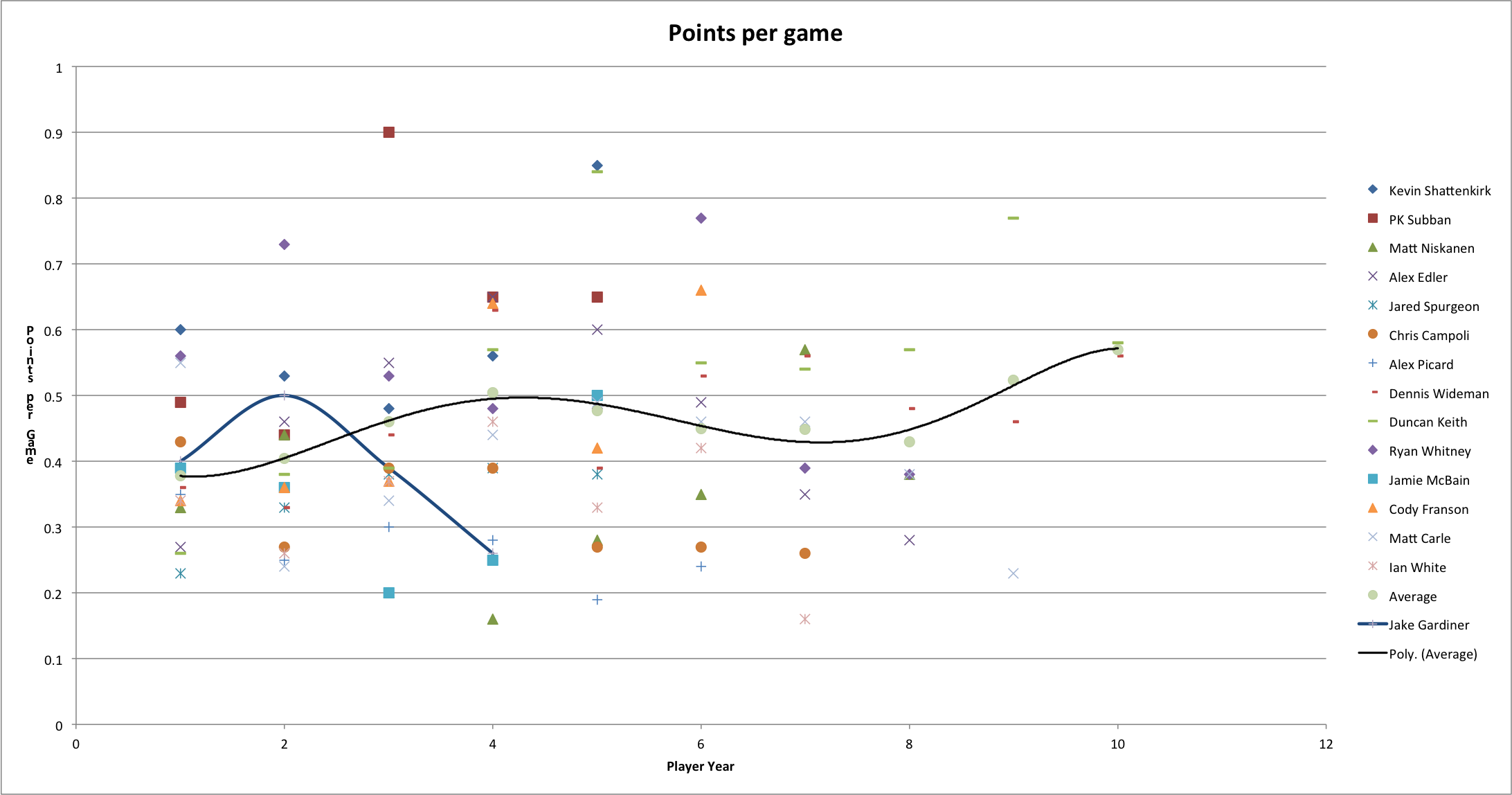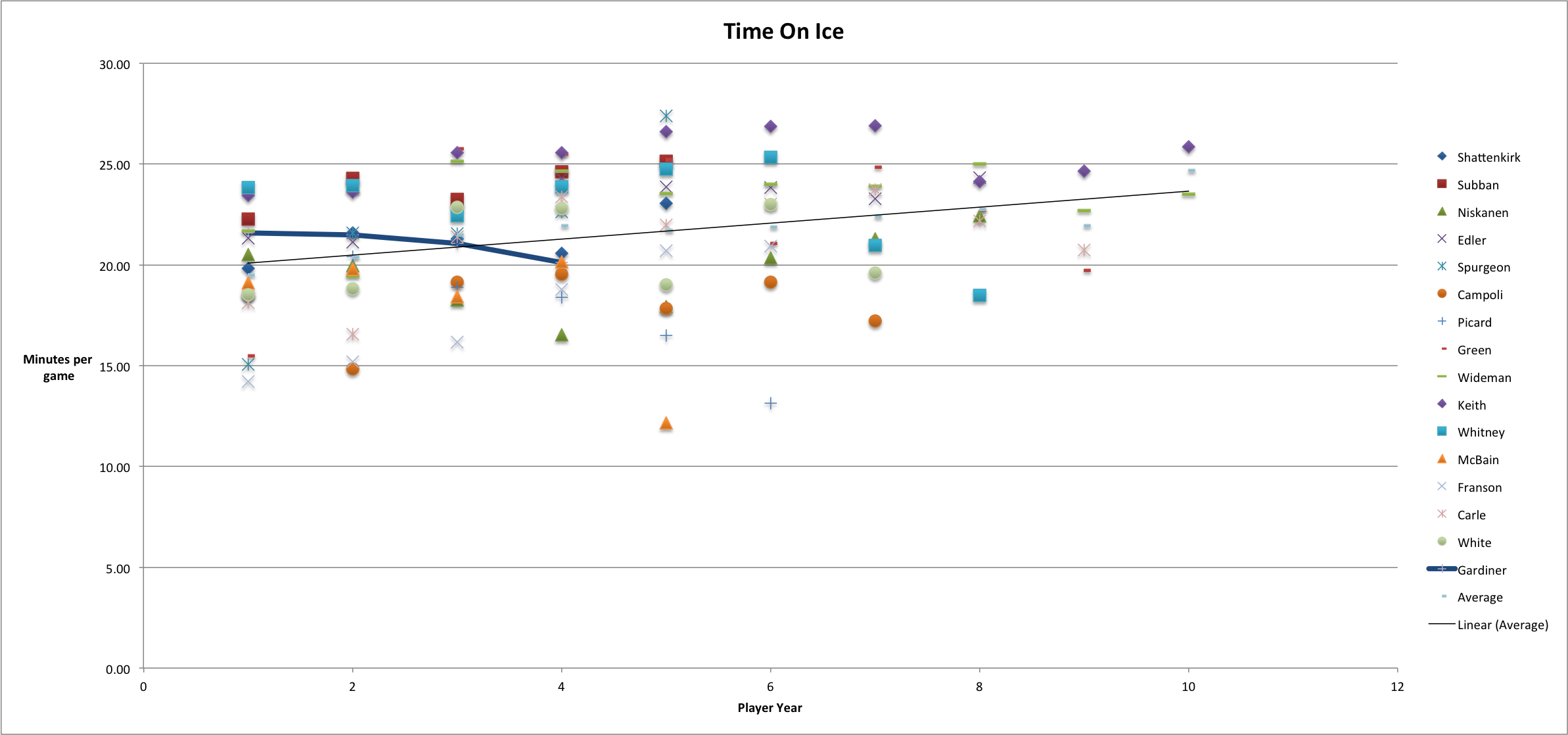And what should the Leafs do with the polarizing young defenceman? The answer isn’t an instantly-gratifying one: Continue to be patient.
[dropcap]T[/dropcap]here is currently no bigger riddle or lightning rod on the Maple Leafs than the 24-year-old, recently-signed-long-term Jake Gardiner. When he broke into the NHL during the 2011-12 campaign, Gardiner was a breath of fresh air, adding a much-needed skill dynamic to the backend while logging 21:35 per game and notching 30 points on the season, good enough to lead all rookie defensemen. In the eight full seasons since the 2005 lockout, only 20 rookie defensemen have scored 30 or more points (and that number is a little inflated because seven of them were after the full lockout year).
Since that season, Gardiner has yet to match the 21:35 he averaged a night, but he also has not played an overwhelming amount of hockey, either. The following season was shortened due to the lockout; Gardiner started the year with the Marlies, where he had 10 goals and 31 points in 43 games overall, but he sustained a concussion and missed most of the NHL season, playing only 12 regular season games. That brings Jake to the 2013-14 campaign, when he was back to averaging over 21 minutes a night and scored 10 goals (tied for 18th for D-men) and 31 points (tied for 45th).
It might feel like Gardiner has been a Leaf for quite some time, but the truth is he has only played two full NHL seasons in his career and has not yet played 200 career games. Over the summer, ex-Leafs coach Scott Gordon addressed the so-called feud between Jake Gardiner and Randy Carlyle, saying:
[pull_quote_center]I can’t tell you how many times that Randy has said that the thought of trading Jake can’t even be discussed until he’s played 300 games. He personally thinks it takes 300 games to get to the point where you can make a decision on them. Here’s somebody who knows there’s going to be growing pains.[/pull_quote_center]
Carlyle, of course, was traded by the Leafs after playing only 110 games (including playoffs) for them in the NHL. In return, Toronto received defenseman Dave Burrows – six years older than Carlyle—who played 151 games as a Leaf at the tail end of his career before returning to Pittsburgh for one more season. Carlyle went on to win a Norris Trophy, finishing his career with 1055 regular season games played and 647 points, tacking on 33 more points in 69 playoff games.
Looking around the league, most executives and coaches seem to subscribe to the theory, “It takes 300 NHL games for a defenseman to develop and to properly evaluate him.” Some who have spoke out on it include Dale Tallon, who noted, “I’ve said this time and time before, but it takes 300 games to become a good NHL defenseman. Historically, that’s the number… It’s a tough position, tough to learn.” John Tortorella is another, and so is Jon Cooper. Player Erik Johnson chimed in saying, “Once I hit that 300-, 350-game mark, I just feel like I really took off. I wish it didn’t take that long for me to play like the way I am, but that’s how it worked out.”
We also see defensemen traded around that mark all the time—recently, the Sharks traded Jason Demers right after his 300th NHL regular season game. In the summer, the Leafs traded Carl Gunnarsson, who played 304 regular season games with Toronto at the time. Even Luke Schenn, moved at age 22 but having played full time in the NHL since age 18, was traded after his 310th game.
According to Quant Hockey’s numbers, “Over half of all NHL players play less that 100 games during their career and for approximately 5 percent of players, their first NHL game is also their last.” Their data only goes until the end of the 2009-10 season, but using their numbers: Out of 1,651 defensemen accounted for, only 532 played over 300 games, or a mere 32%. It has to be taken with a major grain of salt when people discuss trading away a player like Gardiner and assume there are options in house that can step in (Petter Granberg, Matt Finn, etc.). Even Stuart Percy should be viewed with such hesitations; Stuart is 21, the same age Gardiner was when he made the NHL out of camp and proceeded to lead his rookie defence class in scoring. That does not mean Percy will be worse than Gardiner, but the contrast in their development stages at the same age has to be recognized.
With that in mind, let’s look at some puck moving, scoring defensemen who broke into the NHL around Gardiner’s age (21 or 22) in recent years and see how they have progressed in comparison to what Gardiner has done. I went back between the post-2005-lockout season and Gardiner’s rookie season and picked out all the defensemen in Gardiner’s age range who cracked the NHL. That leaves us with a group consisting of Kevin Shattenkirk, Matt Niskanen, Alex Edler, Jared Spurgeon, PK Subban, Chris Campoli, Alex Picard, Mike Green, Cody Franson, Dennis Wideman, Duncan Keith, Ryan Whitney, Jamie McBain, Matt Carle, and Ian White. Let’s see how they did:


What is really interesting about these 15 defensemen is the fact that 11 of them have been traded. Of the four who haven’t, two have won a Norris (Keith, Subban), one was in the hunt for one for a few years (Green, who is also all but done for in Washington, by the way), while the other has been in trade rumours for nearly two years (Edler).
So, what does that tell you about the group of players who make the NHL in their age 21 or 22 seasons and flash promise from the start? Teams are far less willing to be patient as they round out their games (I remember Ray Ferraro saying last year that Gardiner has plateaued and is what he is).
What happens when we look at the trend of those who made it, and those who didn’t? If they could not stick in the top-4 D of a group within the first 2-4 years, they started getting pushed out immediately (Campoli and Picard are among those out of the league altogether). A new crop of promising young players start coming through and their potential gives them a leg up on mid-20 years-old players who have seemingly shown all they can do.
Suffice it to say, teams are pretty well entirely focused on top-four defensemen in this age range, and completely comfortable with filling out their defense with older veterans or younger kids. With both these charts, we see that the defensemen who don’t establish themselves as 20+ minute per game guys find themselves out of the league or playing scrap minutes. On the other chart, we see the type of production teams are looking for: Roughly .45PPG, as the players under the average quickly find themselves either out of the league or deemed overpaid. I also charted out CF% and CF% REL, but decided not to include the charts because they were not very indicative of anything—the numbers fluctuated wildly, were largely team driven for some players, and did not adequately separate the contenders from the pretenders. What we do see out of the players who become successful NHLers, simply put, is that they either start their career scoring and need to grow into the minutes played (Franson, Shattenkirk, Carle), or they start by playing a lot and need time to learn how to score at this level (Keith, Wideman, Edler).
Most of these players became solid top-4 defensemen and are still solid defensemen, but other than a select couple, they fall in the “good but not great” category of players and that makes them expendable. Unless it is an elite team that can afford to be patient, chances are the team is looking for building blocks and have to give to get, which makes these players very attractive. In the case of the Leafs, they desperately need building blocks down the middle and that makes a maybe/probably top-4 defenseman expendable to them, in theory, if they can fill that need.
Earlier in the season, I looked at the trend of Gardiner having weak starts to the season, followed by strong second halves to the schedule. Here is that chart:
| Gardiner | GP | Points | SOG |
|---|---|---|---|
| Oct. 2011 - Dec. 2011 | 35 | 9 | 34 |
| Jan. 2012 - Apr. 2012 | 40 | 21 | 45 |
| Oct. 2013 - Dec. 2014 | 40 | 11 | 60 |
| Jan. 2014 - Apr. 2014 | 40 | 19 | 76 |
So, let us bring all this data together to reach some sort of conclusion. Gardiner’s third full season is following the trend of the first two, with a slow start before he starts picking it up headed toward the halfway point (his numbers have been up the last 20 games or so, I thought the Chicago game was his best of the season, and, like last year, he picked it up after a healthy scratch). The year that the plotted group of defensemen collectively produced the highest output on average was year 4, which would technically be next season for Gardiner and also the season in which he would surpass the 300 games played mark provided he stays healthy. I don’t want to give anyone gambling advice, but if they trade him before next season it would be a pretty good bet that Gardiner has a career-best season elsewhere next year.
In the NHL, there are essentially two points of the year that actual trades of significance occur—the trade deadline and the draft. Provided Gardiner plays the rest of the season, he’ll finish the year having played 247 NHL regular season games, which puts the Leafs in a bit of a tough spot. Trade him before next season and the opposing GM is still gambling on untapped upside with Gardiner – and rightfully so, most data would point to him not reaching his pinnacle yet. Trade him during the 2016 deadline or draft and nobody is gambling on his upside any more. Plus, he has a long-term contract. On that note, it is arguably the best option to ride out the current season before drawing any conclusions here. The usual disclaimer of “if something falls in the Leafs lap like a young center (you know who) then the Leafs should do it,” isn’t necessary because it’s not going to happen. One thing we experienced in the Brian Burke era was the process of building a team through trades and having to acquire other people’s problems, regardless of how good the player is. Burke was able to acquire JVR, Dion Phaneuf, Phil Kessel and Joffrey Lupul among others, who are all good players who also have some ugly warts to their games, too.[quote_right] I don’t want to give anyone gambling advice, but if they trade him before next season it would be a pretty good bet that Gardiner has a career-best season elsewhere next year.[/quote_right]
If rumours mean anything, the Leafs seem to be rushing this decision based on Cody Franson being a pending UFA, but if they take a step back and look at the big picture, Gardiner should not be the sacrificial lamb to retain Franson (at least not right now, anyway). They need to ride the season out and see how he progresses. His numbers have been extremely poor across the board this season and he has been painful to watch at times with his apparent fear of going into the corner to retrieve pucks. The Leafs would be selling at pretty well the lowest of the low with games to spare before he hits the vaunted 300 games played mark. Let him ride out the season, and see how he progresses. Does his play even out? Do his numbers continue to get worse? What will his career body of work look like after the season passes and he has three full years of hockey to his name? Selling young players off because of the emotion of the Leafs playing poorly, right after a long-term extension and not yet in their prime, is a recipe for disaster.
The other side of the spectrum, if they want to and do bring back Franson, is that they already have Phaneuf locked in as a top four and Morgan Rielly is getting there. The long-term view of a Phaneuf, Franson, Rielly and Gardiner top four is going to give the majority of observers pause. However, with Gardiner starting slow again yet having still not played an adequate amount of games to have fully and properly developed, the plan has to be to at least hold off until the end of the season and the draft. I should also note that it is hard to find good defensemen, and a strong second half of the season — followed by Gardiner smoothing over his play in the season where he’ll cross the 300 game mark — would be a big help to the Toronto Maple Leafs.
Almost a decade ago fans were screaming for a full rebuild and tear down. The Leafs haven’t done it the conventional way and are paying the price because of it, but a legitimate part of that process still is waiting 300 games for defensemen to develop. The patience is paying off with Nazem Kadri. The hope should be that it will with Jake Gardiner, too.



![Craig Berube on Nick Robertson joining William Nylander’s line: “If he gets to a good area on the ice, [Nylander] can find him… He has to put a couple in and get some confidence” Craig Berube, Toronto Maple Leafs head coach](https://mapleleafshotstove.com/wp-content/uploads/2024/10/berube-leafs-prac-218x150.jpg)





















![Craig Berube on Nick Robertson joining William Nylander’s line: “If he gets to a good area on the ice, [Nylander] can find him… He has to put a couple in and get some confidence” Craig Berube, Toronto Maple Leafs head coach](https://mapleleafshotstove.com/wp-content/uploads/2024/10/berube-leafs-prac-100x70.jpg)







